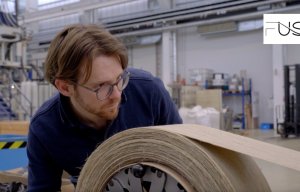UK company develops new 3D knitted carbon fibre preforms
Flat Knitting
Research project to develop manufacturing process for 3D flat knitted composites
Flat knitting machine builder Steiger is participating in a research project which aims to develop a manufacturing process for making complex 3D composite parts for the automotive industry using flat knitting technology.

12th January 2015
Knitting Industry
|
Vionnaz
 Swiss flat knitting machine manufacturer Steiger is participating in a European funded research project that aims to develop a comprehensive process for manufacturing three-dimensional textile composite parts using its advanced flat knitting technology.
Swiss flat knitting machine manufacturer Steiger is participating in a European funded research project that aims to develop a comprehensive process for manufacturing three-dimensional textile composite parts using its advanced flat knitting technology.
The Mapicc 3D project aims to create a manufacturing process, which can make parts from composite fibres such as glass fibre in complex shapes in order to reduce production costs for industries like automotive.
The project, which is part of the European Union’s 7th Framework Project, involves fifteen partners including academics at ENSAIT (École Nationale Supérieure des Arts et Industries Textiles) Mecacorp, Technische Universität Dresden and Riga Technical University, as well as technical textiles corporations Alstom and TenCate and car manufacturer Volvo.
The 3rd dimension
A published paper called Flat Knitting Machine: The 3rd Dimension authored by Steiger Managing Director Pierre-Yves Bonvin explains the project in depth and is available to download in full at the foot of this article.
“The goal is to provide tools ranging from finite element simulation of the final product to the characterisation of the piece and the performance of mechanical tests, all the way to the production of technical textiles, shaping and solidification through a mould,” Pierre-Yves Bonvin explain.

“The European Community has clearly defined the purpose of the project as the development of an industrial tool, which justifies the presence of a machine manufacturer. Steiger was chosen as partner given its long association with universities related to the textile industry.”
Mr Bonvin describes some of the unique characteristics of Steiger’s machines as:
· Motorized yarn guides positioned with an accuracy of 0.5 mm
· Performing take-down allowing traction suitable for the most delicate fabrics with complex shapes
· Through an open carriage, the possibility of feeding the yarn directly to the needle with reduced tension and minimum friction
Mapicc 3D knitted composites use a combination of warp insertion, weft insertion and knitting techniques to create real 3D knitted structures. There area few manufacturers worldwide using flat knitting to create 3D composites but the warp insertion technique employed in the Mapicc 3D project is novel.
“These technical specifications provide a unique tool for the development of new technologies,” Mr Bonvin adds.
The Mapicc 3D project is an alliance of partners specialising in the field of textiles including universities, laboratories, specialists in finite element simulation, machine manufacturers, automotive or aerospace industry suppliers, and transportation related end users.
Some of the project’s detailed objectives include the development of a production system for 3D geometries based on multilayer composite fibres that are shaped by a unique process of thermoplastic solidification.
According to Steiger, the different production stages should allow the use of preform, foam injection, and integration of sensors in the final piece. In parallel with the production process, Mapicc 3D will develop simulation tools of physical and mechanical properties of semi-finished and finished products.
3D knitted drivers seat parts
Mr Bonvin’s paper explains the advantages flat knitting has over weaving, the traditional technology used for manufacturing many composite parts, including the ability to deliver a part which requires no cutting or joining directly from the knitting machine.
In order to validate the whole production chain, a prototype linked to the automotive industry was chosen. Volvo proposed to replace the driver’s seat retaining plate of its vehicle with a piece of knitted fiberglass. The choice of this piece relates to its dimensional complexity and the mechanical resistance. At the end of the validation, the piece will undergo the same tests as a metal piece, including a vehicle crash test.

“In order to achieve an industrial production tool of the knitted preform, we are required to push knitting to its maximum limits,” Pierre-Yves Bonvin explains.
“The machine developed and built for the project inherits the successful experience with two modified Aries 3-type machines installed at the Institute of Textile Machinery and High Performance Material Technology, Technische Universität Dresden since 2006. During these years, researchers at the institute have developed multilayer fabrics. They have validated techniques to mechanically reinforce the knitted fabric by adding weft yarn and warp yarn.”
“Through this experience, the institute was able to demonstrate the benefits of knitting in the field of composite fibres. Weft and warp yarn ensure stress resistance in two axes, and stitches bind the whole piece, providing a substantially final geometry in the preform by using the fully fashion technique.”
“This successful experience has resulted in the transition to 3D. It has guided the specifications for a new machine necessary for this technological leap.
About Steiger
Steiger is a renowned flat knitting machine manufacturer based in Vionnaz, Switzerland. Founded in 1947, the company has been part of the China headquartered Cixing group since 2010 and employs approximately 100 people worldwide.
Steiger is recognised as a technology leader for industrial knitting machines used for technical and medical products. In the fashion world, it is recognised for the quality of its stitch and for its Intarsia machines. The company delivers its products worldwide through an extended sales and service network.
Further information
Download Flat Knitting Machine: The 3rd Dimension by Pierre-Yves Bonvin

Business intelligence for the fibre, textiles and apparel industries: technologies, innovations, markets, investments, trade policy, sourcing, strategy...
Find out more












